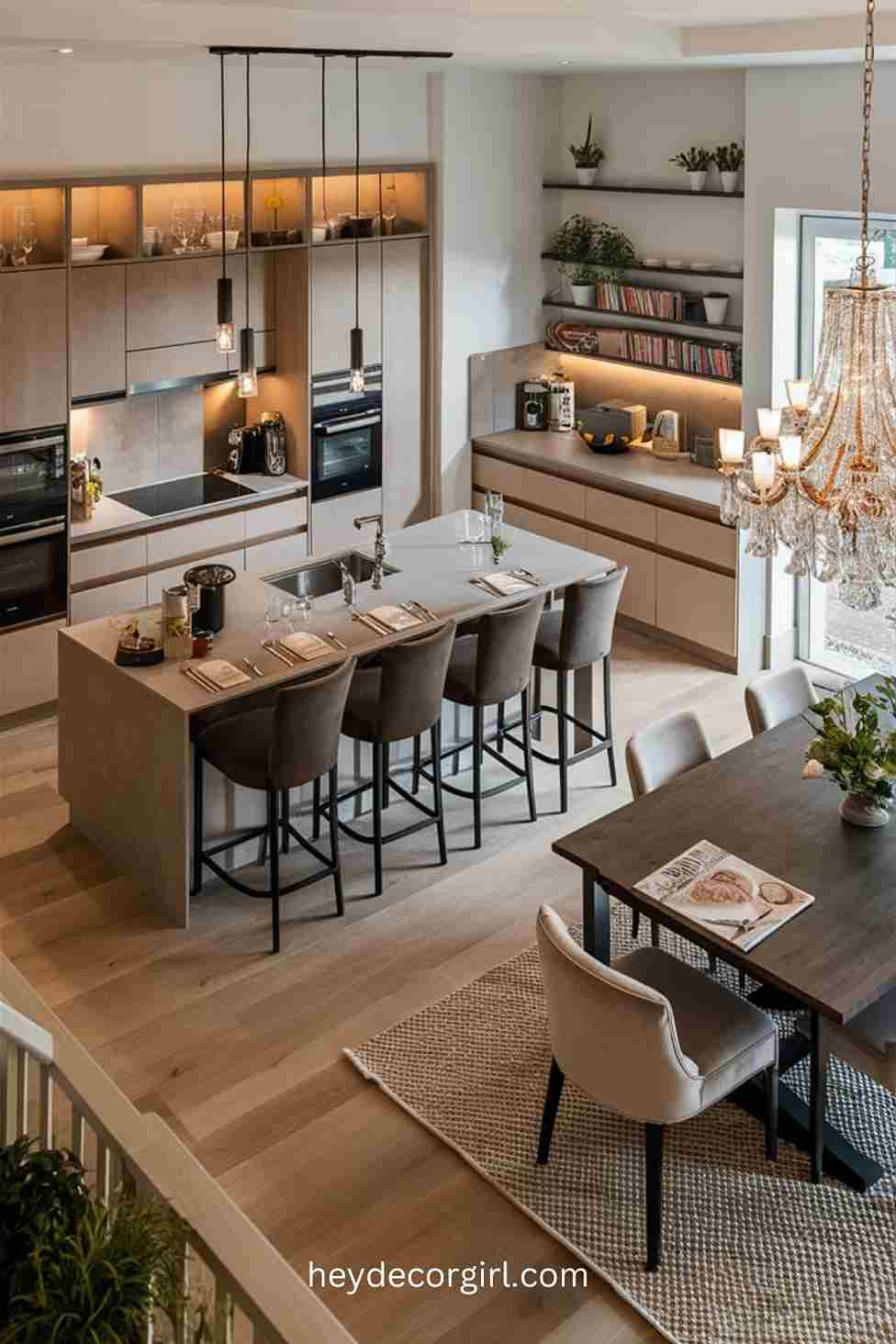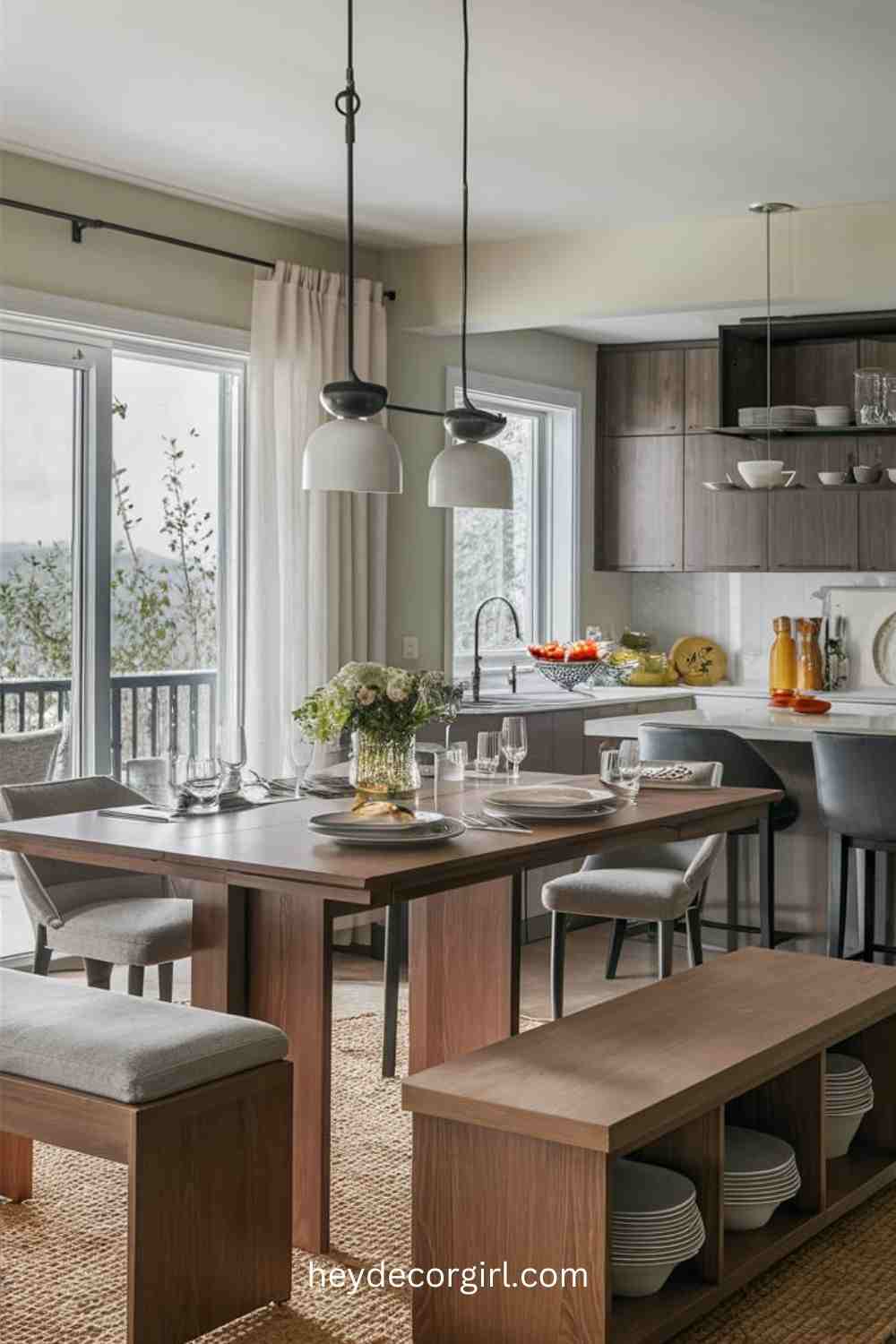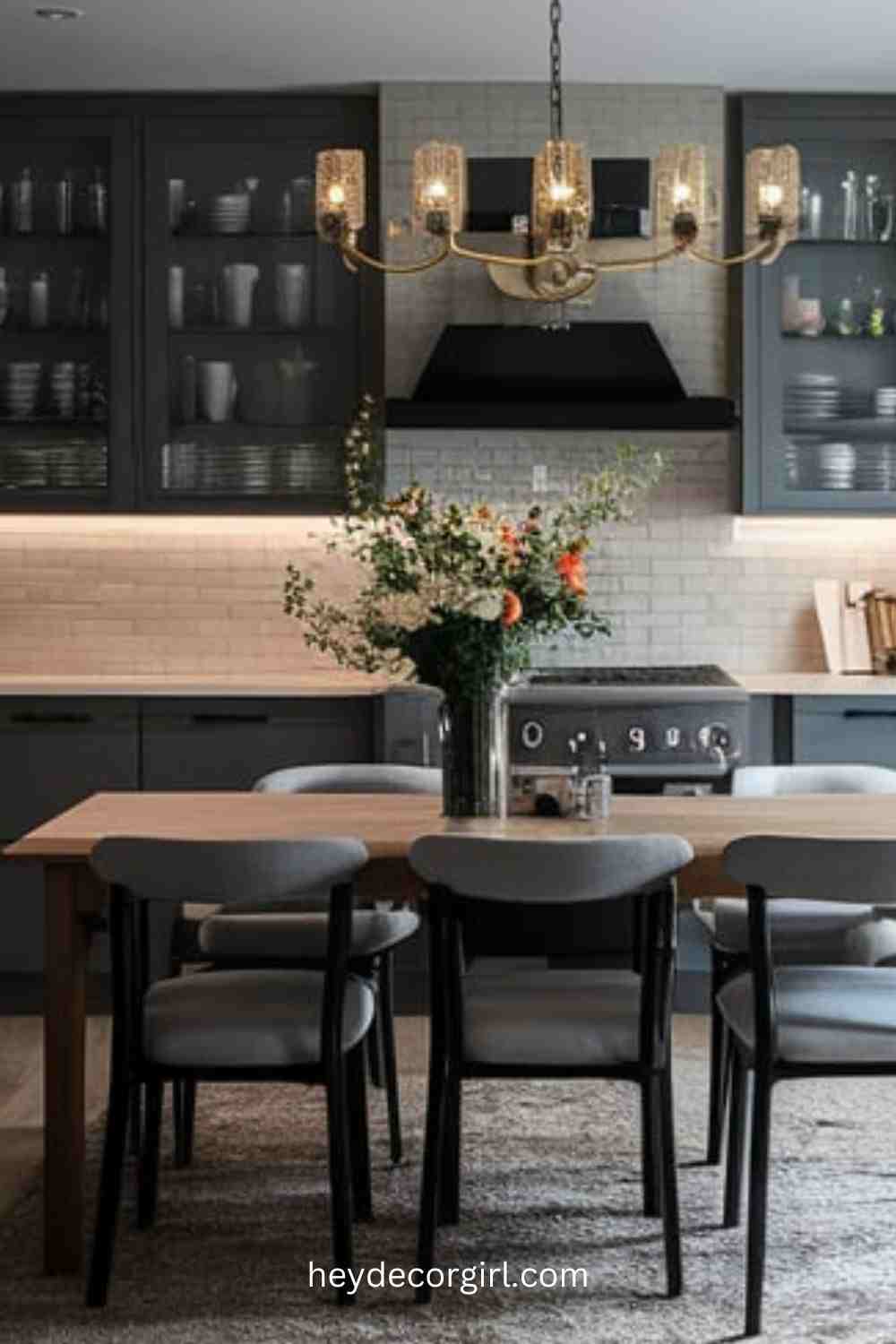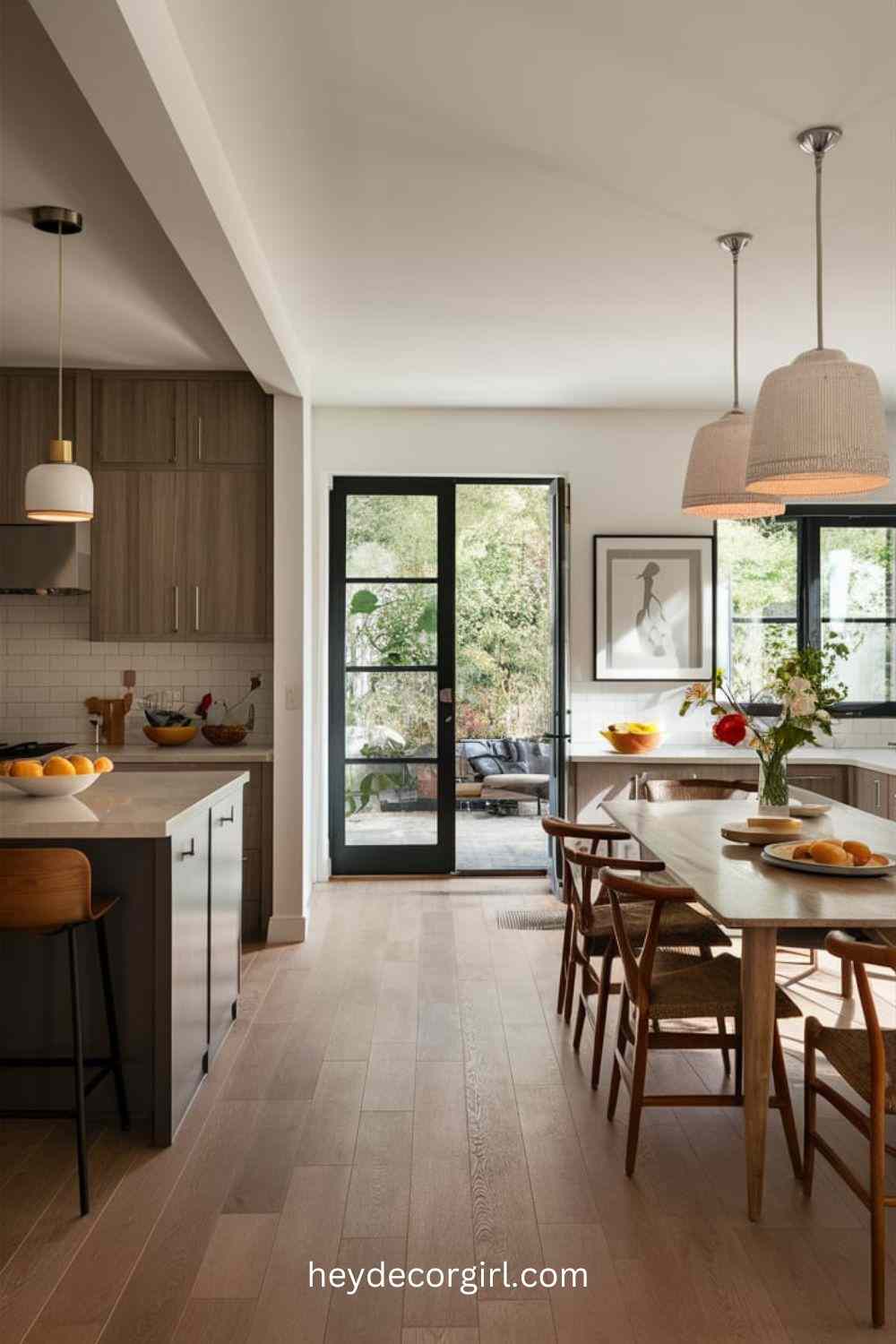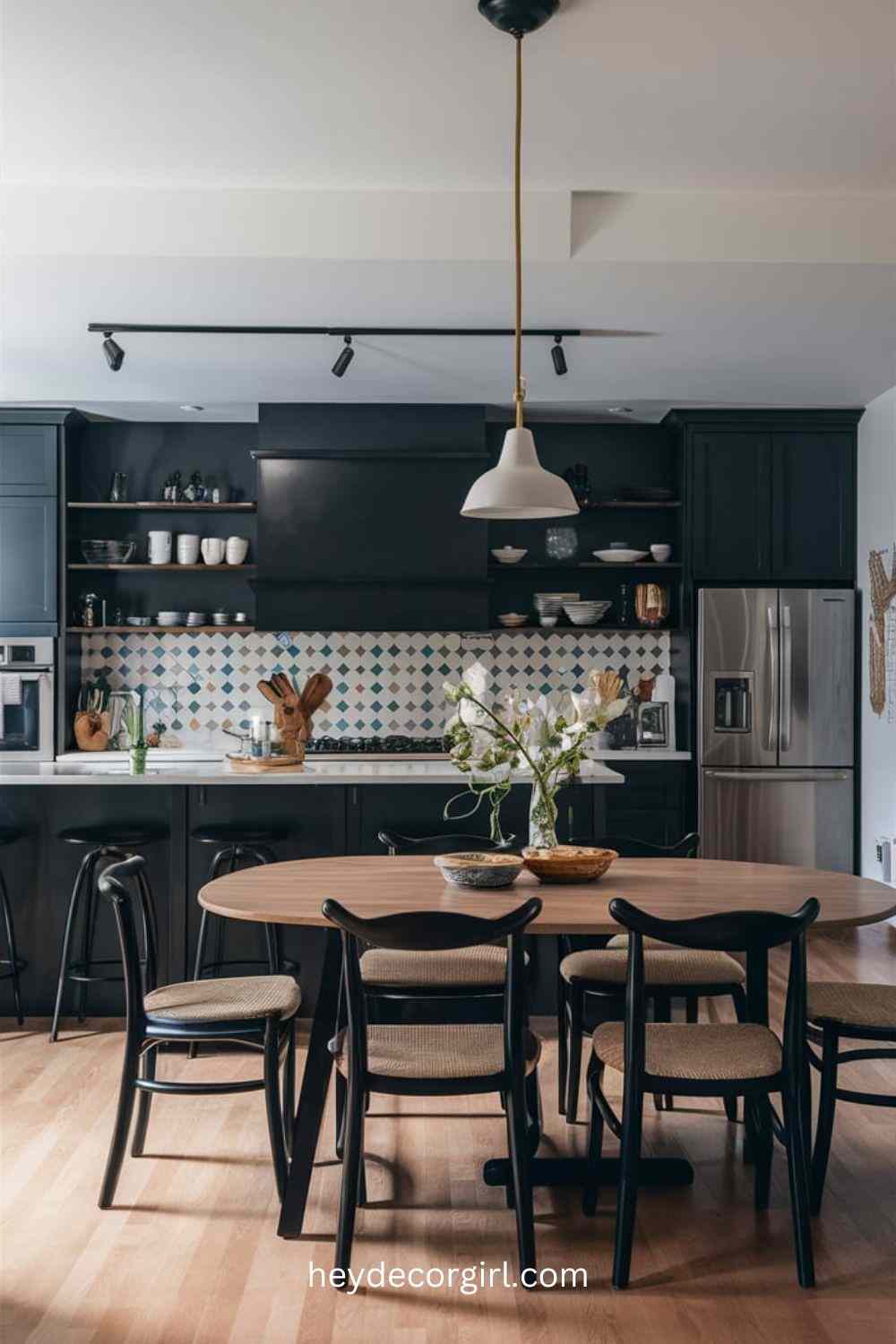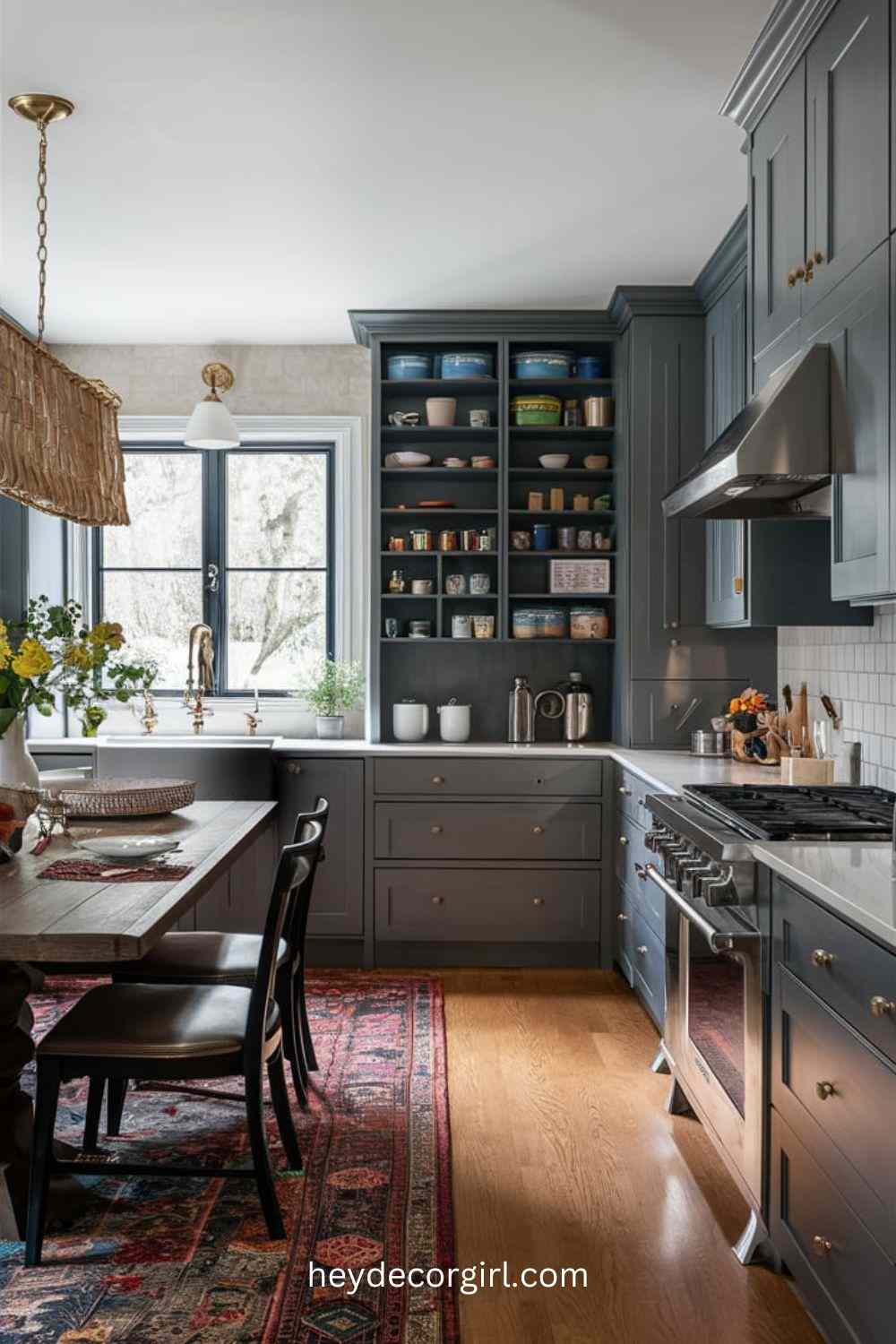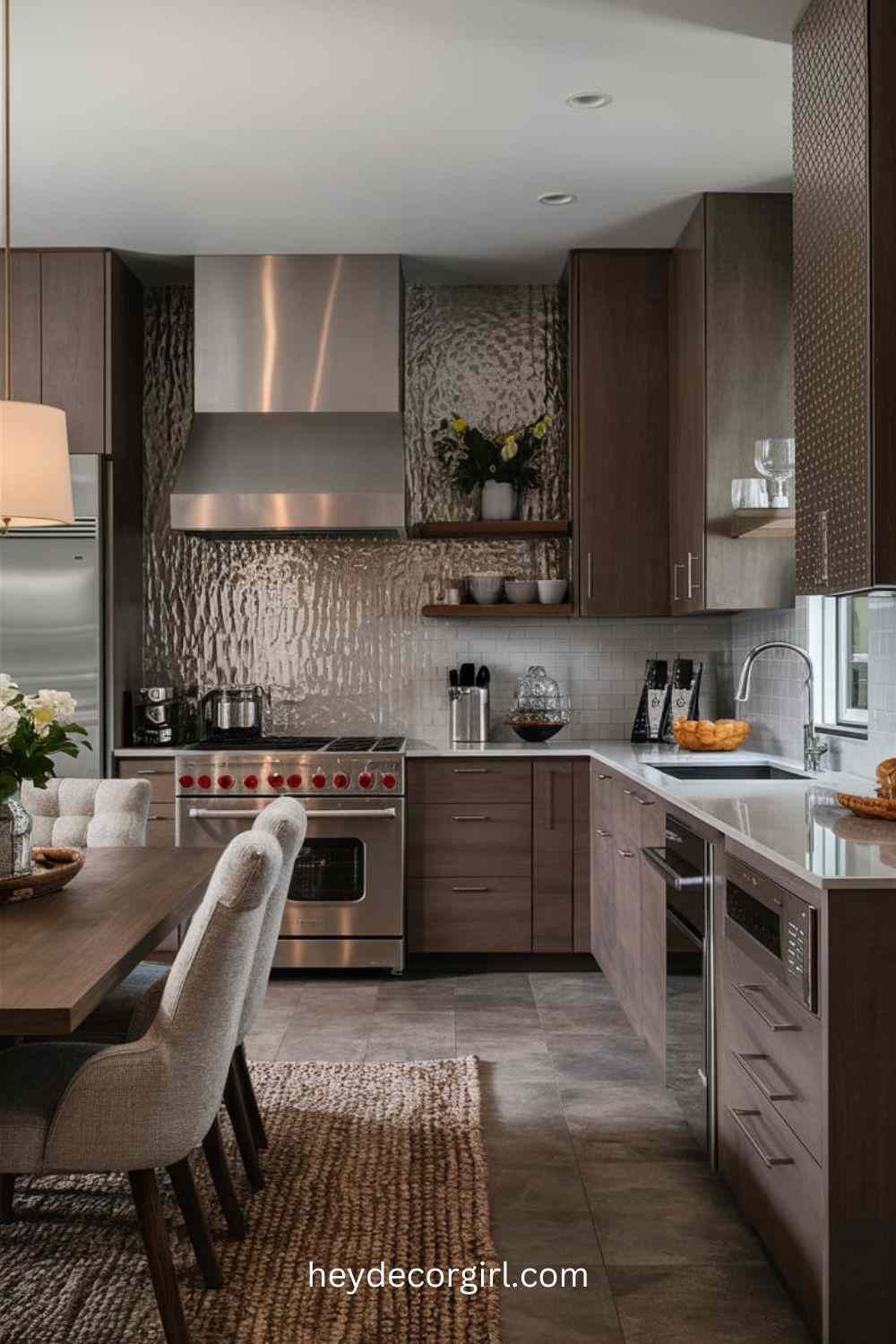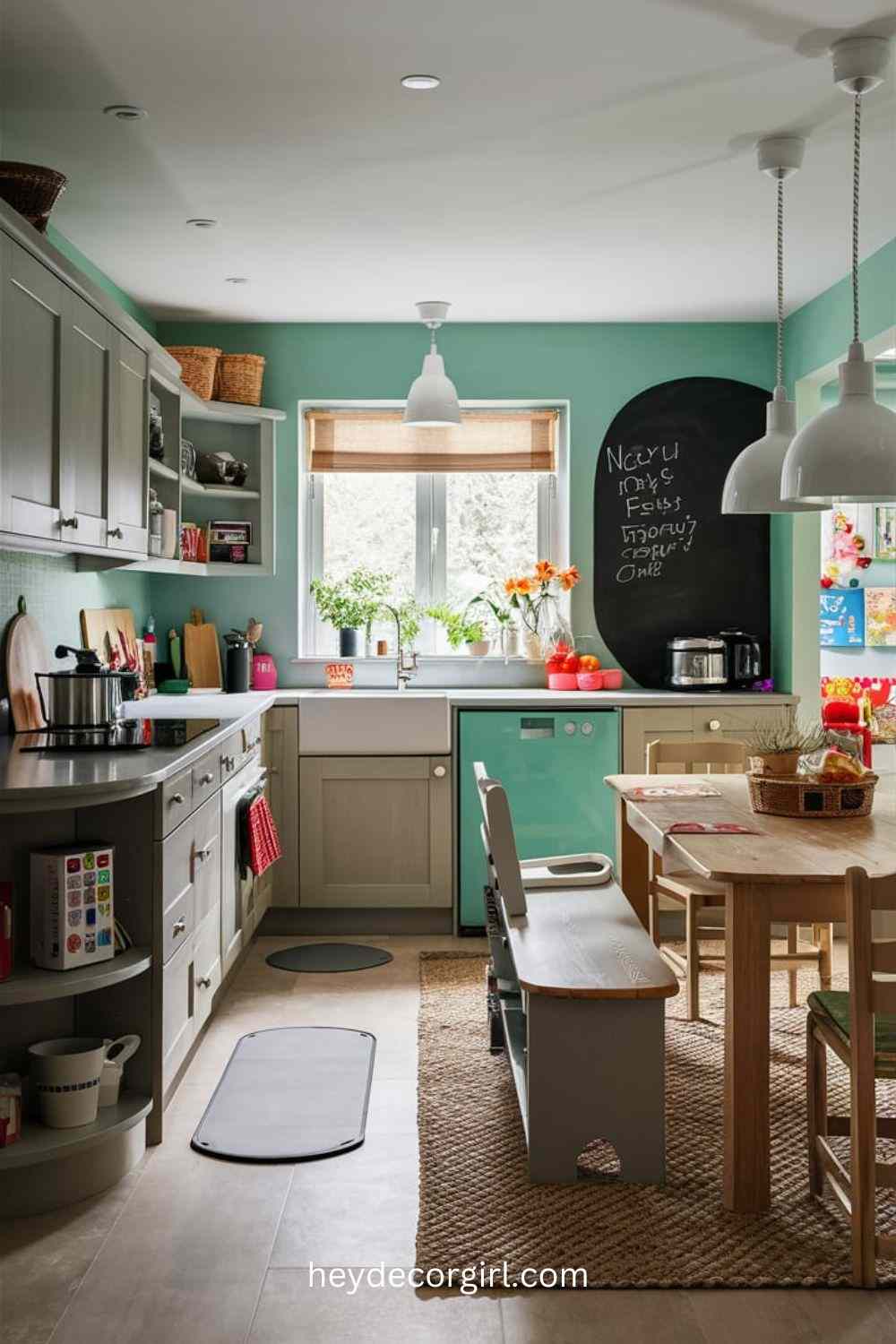Combined Kitchen-Dining Rooms Ideas offer a modern and versatile approach to home design, seamlessly blending the cooking and dining areas into one cohesive space. This concept has become increasingly popular as homeowners seek to maximize functionality while enhancing the aesthetic appeal of their homes. By integrating these two essential areas, you can create a space that not only meets the practical demands of daily life but also fosters a more open and engaging environment for family gatherings and social occasions.
The benefits of merging kitchen and dining spaces are numerous. Firstly, it enhances the flow and connectivity of the home, making it easier to entertain guests and enjoy meals together. The open layout encourages interaction and communication, allowing the cook to stay connected with family and friends while preparing meals. Additionally, a combined space can improve efficiency by reducing the distance between the kitchen and dining areas, making serving and cleanup more convenient.
Best Combined Kitchen-Dining Rooms Ideas
1. Open Floor Plan
Combined Kitchen-Dining Rooms Ideas involve an open floor plan for kitchen-dining areas that entails the removal of walls or barriers traditionally separating these spaces, creating a unified, fluid area where cooking and dining seamlessly coexist. This design approach emphasizes openness and connectivity, allowing for a more natural flow between the kitchen and dining spaces. The lack of physical dividers encourages a sense of spaciousness and enhances the overall functionality of the home, making it ideal for both daily living and entertaining.
Examples of Seamless Transitions Between Spaces
- Continuous Flooring: Using the same flooring material throughout the kitchen and dining areas helps create a visual connection between the two spaces. For instance, hardwood floors or polished concrete can extend across both areas, providing a cohesive look and making the space feel larger.
- Open Shelving: Incorporating open shelving or a low partition can act as a subtle boundary while maintaining the open feel. For example, a set of floating shelves or a breakfast bar can delineate the kitchen from the dining area without blocking sightlines.
- Consistent Color Palette: Employing a unified color scheme throughout the kitchen and dining areas helps create a harmonious environment. For instance, if the kitchen features white cabinets, extending the same color onto dining room walls or furniture can maintain visual continuity.
- Matching Fixtures and Hardware: Coordinating lighting fixtures, cabinet hardware, and other details between the two areas ensures a cohesive look. A chandelier over the dining table that complements pendant lights in the kitchen can unify the design.
Tips for Maintaining Visual Continuity
- Unified Design Elements: Select design elements that flow seamlessly from one area to another. For example, use the same countertops and cabinetry styles in both the kitchen and dining areas to tie the spaces together visually.
- Consistent Style and Theme: Choose a style or theme that works throughout the entire space. Whether you opt for a modern, minimalist approach or a more traditional design, maintaining consistency in furniture, decor, and materials will ensure a cohesive look.
- Strategic Use of Rugs: If you prefer distinct zones, use area rugs to define each space while maintaining a connection. A rug under the dining table can anchor the dining area without disrupting the open feel of the room.
- Open Sight Lines: Arrange furniture and layout in a way that maintains open sight lines. Avoid placing large furniture pieces or tall objects that might obstruct views or make the space feel fragmented.
- Color and Texture Coordination: Use complementary colors and textures to create a sense of unity. For example, if you have a textured backsplash in the kitchen, consider incorporating similar textures in the dining area, such as a textured wall art or fabric.
By thoughtfully designing and coordinating these elements, you can achieve a beautifully integrated open kitchen-dining area that feels both functional and inviting.
2. Multi-Functional Furniture
In a combined kitchen-dining room, multi-functional furniture plays a crucial role in maximizing space and enhancing versatility. Here are some innovative combined kitchen-dining rooms ideas for furniture that adapts to your needs:
1. Expandable or Drop-Leaf Tables
- Expandable Tables: These tables feature hidden leaves or sections that can be pulled out to accommodate extra guests. They’re ideal for small spaces, as they can be compact when not in use and expanded when needed.
- Drop-Leaf Tables: With hinged leaves that can be folded down when not in use, drop-leaf tables are perfect for tight spaces. They offer flexibility in both size and shape, making them a great choice for dynamic kitchen-dining rooms.
2. Adjustable Height Tables
- Height-Adjustable Tables: These tables can be raised or lowered to suit different purposes, such as dining or casual gatherings. Some models even include adjustable legs or mechanisms that allow the table height to be changed easily.
- Counter-Height Tables: These tables can double as both a dining surface and additional prep space. When paired with barstools, they provide a casual dining option that blends seamlessly with kitchen countertops.
3. Convertible Tables
- Table to Desk Conversions: Some tables can transform into a desk or work surface when not being used for meals. This feature is particularly useful in multi-purpose spaces where a home office may be integrated into the kitchen-dining area.
- Table to Buffet Conversions: Tables with built-in storage that can be used as a buffet or sideboard for serving food during gatherings. When not in use for dining, these tables can provide additional storage or surface space.
4. Storage Solutions That Double as Seating
- Storage Benches: Benches with built-in storage provide extra seating while also offering space for storing kitchen essentials, dining accessories, or even seasonal items. They’re a practical choice for both aesthetics and functionality.
- Ottomans with Storage: Ottomans that open up to reveal hidden storage are perfect for extra seating and keeping clutter at bay. They can be used around the dining table or in other parts of the combined space.
5. Modular Seating
- Modular Sofas or Sectionals: These pieces can be rearranged or expanded to suit different needs, providing both seating and storage options. They’re particularly useful in open-plan spaces where flexibility is key.
- Modular Dining Sets: Modular dining furniture allows you to adjust the arrangement of chairs and tables to fit various occasions, whether it’s a large family dinner or an intimate gathering.
By incorporating multi-functional furniture into your combined kitchen-dining room, you can create a space that adapts to your needs and enhances both functionality and style. These versatile pieces not only make the most of your available space but also add a practical and elegant touch to your home.
3. Color Coordination
- Choose a Unified Color Palette
- Base Colors: Start with a neutral base color for walls, floors, and major furniture pieces. Neutrals like white, beige, or gray create a clean backdrop and allow other colors to stand out.
- Accent Colors: Incorporate accent colors through decor items, cabinetry, or textiles. These colors can be drawn from nature, trends, or personal preferences and should complement the base colors.
- Coordination: Ensure that the colors used in the kitchen and dining areas are consistent or complement each other to maintain visual continuity.
- Examples of Color Palettes That Work Well
- Classic Monochrome
- Palette: Shades of white, gray, and black.
- Description: A monochrome scheme offers a timeless and elegant look. Use white or light gray for walls and cabinetry, while incorporating darker gray or black for accents such as bar stools or dining chairs. This palette creates a sophisticated and cohesive look that works well in modern or minimalist designs.
- Warm Neutrals
- Palette: Beige, taupe, and warm brown.
- Description: Warm neutrals create a cozy and inviting atmosphere. Beige or taupe walls can be paired with warm brown cabinets or dining furniture. Add pops of color through accessories like cushions or table settings in complementary hues for a balanced and warm look.
- Cool Blues and Greens
- Palette: Soft blue, mint green, and white.
- Description: Cool colors evoke a fresh and calming feel. Soft blue or mint green walls paired with white cabinetry can create a serene environment. Incorporate blue and green accents in decor items or textiles to enhance the cohesive look.
- Earthy Tones
- Palette: Olive green, terracotta, and cream.
- Description: Earthy tones bring a natural and grounded feel to the space. Olive green walls or cabinetry combined with terracotta or cream accents can create a warm, organic atmosphere. Use natural materials and textures to complement this palette.
- Bold Contrast
- Palette: Navy blue, gold, and white.
- Description: For a more dramatic look, combine bold colors like navy blue with gold or brass accents. Navy blue cabinetry or a feature wall can be paired with white dining furniture and gold hardware or decor elements to create a striking contrast that adds depth and character.
- Classic Monochrome
By carefully selecting and coordinating colors, you can ensure that your combined kitchen-dining room feels cohesive and visually appealing, enhancing both functionality and style in your home.
4. Lighting Solutions
Effective lighting is crucial in combined kitchen-dining rooms, as it helps define different zones and enhances both functionality and ambiance. By incorporating various types of lighting, you can create a well-balanced space that meets the needs of both cooking and dining areas. These combined kitchen-dining rooms ideas showcase how strategic lighting can transform the overall atmosphere and usability of the space.
1. Task Lighting Task lighting is essential for illuminating areas where specific tasks are performed. In the kitchen, this includes the countertops, stove, and sink areas. Under-cabinet lights are a popular choice for task lighting, as they provide direct illumination for food preparation and cooking. These lights can be installed on the underside of upper cabinets or on shelves, ensuring that the work surfaces are well-lit without creating harsh shadows.
2. Ambient Lighting Ambient lighting provides overall illumination for the entire space, creating a comfortable and welcoming atmosphere. In a combined kitchen-dining room, this type of lighting helps to fill the room with a soft, even light. Ceiling-mounted fixtures, such as recessed lights or flush-mount ceiling lights, are effective for general ambient lighting. Dimmer switches can be used to adjust the brightness according to the time of day or the mood you want to create.
3. Accent Lighting Accent lighting adds visual interest and highlights specific features or architectural elements. For example, you might use LED strips or spotlights to illuminate a backsplash, artwork, or a feature wall. This type of lighting can also be used to highlight the dining area, drawing attention to the table and creating a focal point for meals and gatherings.
4. Pendant Lights Pendant lights are a stylish choice for the dining area and can serve as both a decorative and functional element. Hanging pendant lights over the dining table provides focused illumination for meals and adds a touch of elegance to the space. Choose from a variety of styles, such as sleek modern designs, rustic farmhouse looks, or colorful vintage options, to match your overall decor.
5. Chandeliers For a more dramatic and sophisticated touch, consider incorporating a chandelier in the dining area. Chandeliers can serve as a statement piece, enhancing the room’s aesthetic while providing ample lighting for dining activities. Opt for a chandelier that complements the size and style of your dining table and the overall design of the room.
By thoughtfully incorporating a mix of task, ambient, and accent lighting, along with stylish pendant lights, chandeliers, and under-cabinet lights, you can achieve a well-lit and visually appealing combined kitchen-dining room. This approach ensures that both functional and aesthetic needs are met, making the space more enjoyable and practical for everyday use and entertaining.
5. Flooring Options
When designing a combined kitchen-dining room, the choice of flooring plays a crucial role in defining the space’s overall look and functionality. In exploring combined kitchen-dining rooms ideas, whether you choose to match or contrast flooring materials, or use different materials to create distinct zones, the right flooring can enhance both the style and practicality of the area.
Matching Flooring Choices
Opting for the same flooring throughout the kitchen and dining areas can create a seamless and cohesive look. This approach is ideal for smaller spaces where continuity can help make the room feel more expansive. Common flooring options that work well in both areas include:
- Hardwood: Offers a warm, classic look and durability. It’s easy to maintain and complements various decor styles.
- Luxury Vinyl Plank (LVP): Mimics the look of wood or stone while being water-resistant and low-maintenance, making it a practical choice for high-traffic areas.
- Tile: Available in a range of styles and colors, tiles are durable and easy to clean, making them suitable for both the kitchen and dining areas.
Contrasting Flooring Choices
Using different flooring materials in the kitchen and dining areas can help define each space while adding visual interest. This approach can be particularly effective in larger open-plan areas. Some ideas for contrasting flooring include:
- Wood in Dining Area and Tile in Kitchen: Wood provides a warm and inviting feel in the dining area, while tile’s water-resistant properties make it ideal for the kitchen.
- Different Tile Patterns: Use a bold or patterned tile in the kitchen to create a focal point, while choosing a simpler or complementary tile for the dining area.
- Different Colors or Finishes: For a more subtle contrast, select different colors or finishes of the same flooring material. For example, a darker shade in the kitchen and a lighter shade in the dining area can create a harmonious yet distinct separation.
Creating Zones with Different Flooring Materials
Designing distinct zones within a combined kitchen-dining room can help define each area while maintaining a unified overall look. Here are some ideas for using different flooring materials to create zones:
- Area Rugs: Use rugs to visually separate the dining area from the kitchen. Choose durable, stain-resistant rugs that complement the flooring in each zone.
- Transition Strips: Install transition strips between different flooring materials to ensure a smooth and safe change from one material to another.
- Flooring Patterns: Incorporate different patterns or layouts, such as herringbone in the kitchen and a grid pattern in the dining area, to subtly define each zone while keeping the design cohesive.
By thoughtfully selecting and arranging flooring options, you can enhance the functionality and aesthetic appeal of your combined kitchen-dining room, creating a space that is both stylish and practical.
6. Stylish Backsplashes
A stylish backsplash can be a defining feature in combined kitchen-dining rooms ideas, serving both functional and aesthetic purposes. By selecting a backsplash that harmonizes with the design of both areas, you can create a cohesive look that visually connects the kitchen and dining spaces. Here’s how to use backsplashes as a design element and some examples of materials and patterns to consider:
Design Integration
- Visual Continuity: Choose a backsplash that complements the overall color scheme and style of both the kitchen and dining areas. This helps create a seamless flow between the two spaces, making them feel more connected. For instance, if your kitchen features a sleek modern design, a backsplash with clean lines and a minimalist pattern can help maintain that aesthetic in the dining area.
- Focal Point: Use the backsplash to create a focal point that draws attention and ties together the design elements of the kitchen and dining room. This can be achieved through the use of bold colors, unique patterns, or eye-catching materials.
- Transition Zones: In spaces where the kitchen and dining areas meet, the backsplash can act as a visual transition. This is particularly effective in open-plan layouts, where a well-chosen backsplash can bridge the two areas and enhance the sense of unity.
Materials and Patterns
- Subway Tiles: Classic and versatile, subway tiles can be used in various layouts, such as traditional brick patterns or more contemporary vertical arrangements. They work well in both modern and traditional designs, making them a great choice for tying the kitchen and dining areas together.
- Mosaic Tiles: Mosaics offer a wide range of patterns and colors, allowing you to create a custom look that reflects your personal style. Whether you choose a geometric design, a subtle blend of colors, or intricate patterns, mosaic tiles can add visual interest and connect different design elements.
- Glass Tiles: Glass backsplashes provide a sleek, modern look with a reflective quality that enhances light and space. They come in a variety of colors and finishes, including frosted, glossy, and iridescent, making them suitable for creating a seamless transition between the kitchen and dining areas.
- Natural Stone: Materials like marble, granite, or slate add a touch of luxury and sophistication. Stone backsplashes can create a strong visual link between the kitchen and dining areas, especially when using similar stone or complementary finishes in both spaces.
- Patterned Ceramic Tiles: For a more eclectic or artistic approach, consider patterned ceramic tiles. These can introduce a playful or unique element into the design, serving as a conversation starter and visually tying together the kitchen and dining areas.
- Metal Tiles: Stainless steel, copper, or bronze tiles add a sleek and contemporary touch to your space. They work well with modern and industrial styles and can create a cohesive look when used consistently throughout both the kitchen and dining areas.
- Color-Block Designs: Using different colors or shades of tiles in a color-block design can create a bold visual statement. This technique can highlight specific zones or features and establish a strong connection between the kitchen and dining areas.
By selecting a backsplash that serves as a design feature, you can enhance the visual appeal of your combined kitchen-dining room. Whether you opt for classic subway tiles, striking mosaics, or elegant natural stone, the right backsplash will help tie the two areas together, creating a harmonious and stylish space.
7. Integrated Storage Solutions
In a combined kitchen-dining room, integrated storage solutions play a crucial role in maintaining a clean and organized space while addressing the functional needs of both areas. By incorporating built-in cabinetry and shelving that serve both kitchen and dining purposes, you can create a seamless, clutter-free environment. Here’s how to achieve Combined Kitchen-Dining Rooms Ideas:
Built-In Cabinetry
- Custom Cabinets: Design custom cabinetry that merges kitchen and dining functions. For example, a long, built-in cabinet can house both kitchen essentials (like pots and pans) and dining items (like plates and glasses), providing easy access while maintaining a unified look.
- Pantry Solutions: Integrate pantry cabinets into the kitchen area that also serve dining needs. Consider pull-out shelves or deep drawers that can accommodate both food storage and dining accessories, making it easy to transition from meal prep to serving.
- Bench Seating with Storage: Incorporate built-in bench seating along one side of the dining table. The bench can include hidden storage compartments for extra dining items or kitchen gadgets, keeping everything within reach but out of sight.
- Vertical Storage: Utilize tall cabinets that extend from the floor to the ceiling. These cabinets can be divided into sections for different purposes—such as one section for kitchen storage and another for dining ware—maximizing vertical space.
Shelving Solutions
- Open Shelving: Install open shelves that span both the kitchen and dining areas, creating a cohesive look. Use these shelves to display attractive dishware, glassware, and decorative items that enhance the design of both spaces.
- Floating Shelves: Incorporate floating shelves along the walls, which can be used for both kitchen essentials and dining décor. These shelves provide an airy, modern look and make it easy to access frequently used items.
- Built-In Nooks: Create built-in nooks or alcoves in the walls for storing items like cookbooks, wine bottles, or serving trays. These nooks can be designed to blend seamlessly with both the kitchen and dining room, providing functional storage without disrupting the flow of the space.
Creative Ways to Hide Appliances and Clutter
- Cabinet Panels: Use cabinet panels to conceal appliances such as refrigerators, dishwashers, and microwaves. This approach ensures that these appliances blend with the cabinetry and maintain a cohesive, streamlined appearance.
- Concealed Appliances: Design cabinetry with retractable or folding doors that hide appliances when not in use. For example, a built-in coffee maker or toaster can be tucked away behind cabinet doors to keep countertops clear.
- Sliding or Folding Doors: Incorporate sliding or folding doors to create hidden storage areas for kitchen and dining clutter. These doors can be used to conceal items like recycling bins or extra dishware, providing easy access while maintaining a tidy appearance.
- Integrated Wine Storage: Include built-in wine racks or coolers within the cabinetry that seamlessly integrate into the design of the kitchen and dining areas. This approach not only hides wine storage but also adds a touch of sophistication to the space.
- Drawer Inserts and Organizers: Use drawer inserts and organizers to keep utensils, cutlery, and other kitchen tools neatly arranged. This prevents clutter from accumulating in drawers and makes it easier to find what you need.
By implementing these integrated storage solutions, you can enhance the functionality and aesthetic appeal of a combined kitchen-dining room, ensuring that the space remains organized, efficient, and visually cohesive.
8. Functional Island or Bar Area
A well-designed island or bar area can be the heart of a combined kitchen-dining room, serving as both a practical workspace and a casual dining spot. Here’s how to create an island or bar area that maximizes functionality and style: Combined Kitchen-Dining Rooms Ideas for integrating these spaces seamlessly and effectively.
Designing an Island that Serves Both Cooking and Dining Needs
- Size and Shape: The size and shape of your island should be proportionate to the overall space. For larger areas, a sprawling island with multiple functions, such as cooking, prep, and dining, works well. In smaller spaces, consider a compact, multi-purpose island that fits comfortably without overwhelming the room.
- Integrated Appliances: Incorporate essential appliances like a cooktop, sink, or dishwasher into the island to streamline cooking processes and keep everything within reach. This integration minimizes the need to move between the kitchen and dining areas, enhancing efficiency.
- Storage Solutions: Equip the island with ample storage, including cabinets, drawers, and open shelves. This can help keep the space organized by providing easy access to kitchen essentials and dining ware.
- Prep Space: Ensure there’s enough counter space for meal prep, including areas for chopping, mixing, and plating. A durable countertop material, such as quartz or granite, can handle heavy use while adding a touch of elegance.
- Design Cohesion: Choose materials and finishes that complement the rest of your kitchen and dining area. Whether you opt for a sleek, modern design or a rustic, farmhouse style, ensure that the island seamlessly integrates with your overall decor.
Bar Seating Ideas for Casual Dining
- Counter-Height Seating: Incorporate counter-height stools or chairs that fit comfortably under the island’s overhang. This arrangement allows for casual dining and socializing while maintaining a clear line of sight across the room.
- Adjustable Heights: Consider stools with adjustable heights to accommodate different users and preferences. This flexibility can make the space more versatile, catering to both dining and casual gatherings.
- Built-In Seating: For a more permanent solution, build seating directly into the island design. This can create a streamlined look and provide additional storage underneath the seats.
- Comfort and Style: Choose seating that combines comfort with style. Upholstered stools with backrests can enhance comfort, while sleek metal or wooden options can add a touch of sophistication.
- Lighting: Install pendant lights or a chandelier above the island to create a focal point and provide adequate illumination for dining. This not only enhances the functionality of the space but also adds to its visual appeal.
By thoughtfully designing a functional island or bar area, you can create a space that not only serves your cooking and dining needs but also becomes a central hub for gathering and entertaining.
9. Textural Contrast
In Combined Kitchen-Dining Rooms Ideas, textural contrast is a powerful design tool that can significantly enhance the visual and tactile appeal of the space. By thoughtfully mixing textures, you can add depth and interest to the room while also defining different functional zones. Here’s how:
Mixing Textures to Add Interest
Combining various textures—such as wood, metal, and fabric—creates a dynamic and engaging environment. For instance:
- Wood: Adds warmth and natural beauty. Wooden cabinetry, dining tables, or accent walls can bring a cozy, inviting feel to the space.
- Metal: Introduces a sleek, modern touch. Incorporate metal elements through light fixtures, bar stools, or kitchen appliances to create a sophisticated contrast with softer textures.
- Fabric: Offers comfort and softness. Use fabric in dining chairs, cushions, or curtains to add a layer of coziness and visual softness.
Layering these textures helps to break up visual monotony and adds character to the space. For example, a sleek metal range hood can stand out against a backdrop of warm wooden cabinetry, while soft fabric dining chairs provide a contrast to the hard surfaces of a wooden dining table.
Defining Different Zones with Textures
Textural contrast can also be used to subtly delineate different areas within a combined kitchen-dining room:
- Kitchen Zone: Opt for durable, easy-to-clean materials such as tiles or stainless steel for the kitchen area. These textures are practical for cooking environments and help define the cooking space.
- Dining Zone: Use softer textures such as plush fabrics for chairs or rugs under the dining table. This creates a distinct dining area that feels separate from the kitchen while maintaining a cohesive design.
- Transitional Areas: Employ contrasting textures in transitional spaces, like a textured backsplash that separates the kitchen from the dining area or a different flooring material to subtly indicate the change in function.
By thoughtfully integrating and contrasting textures, you can not only enhance the aesthetic appeal of your combined kitchen-dining room but also create a functional and comfortable environment that clearly defines each area within the space.
10. Family-Friendly Features
Designing a combined kitchen-dining room that accommodates families and children involves creating a space that is both practical and safe while still being stylish and functional. Here are some key considerations and tips for achieving a family-friendly design, including combined kitchen-dining rooms ideas:
Designing Spaces for Families and Children
- Durable Materials:
- Flooring: Choose durable and easy-to-clean flooring materials such as vinyl, tile, or hardwood. These are resistant to spills and stains, making them ideal for busy family life.
- Surfaces: Opt for countertops made of materials like quartz or laminate that can withstand heavy use and are easy to maintain.
- Child-Friendly Furniture:
- Seating: Select sturdy, easy-to-clean furniture. Consider rounded edges on tables and chairs to prevent injuries. High chairs or booster seats should be easy to secure and remove.
- Storage: Incorporate low, accessible storage for children’s items such as snacks, dishes, and toys, so they can independently reach what they need without causing disruption.
- Adjustable Lighting:
- Safety: Ensure that lighting is sufficient and adjustable to accommodate various activities. Include dimmable lights in the dining area to create a comfortable ambiance and bright task lighting in the kitchen for cooking.
- Open Layout:
- Space: Maintain an open and clutter-free layout to allow children to move freely. An open plan helps supervise kids more easily while cooking or entertaining.
- Interactive Zones:
- Activity Areas: Create a dedicated space for children’s activities, such as a small play area with a chalkboard wall or a kid-friendly craft station. This keeps them entertained and engaged while adults are in the kitchen.
Tips for Safety and Practicality
- Childproofing:
- Cabinet Locks: Install cabinet locks on lower cabinets to keep hazardous items out of reach.
- Stove Guards: Use stove guards to prevent children from accidentally touching hot surfaces or reaching into the oven.
- Non-Slip Rugs:
- Safety: Place non-slip mats or rugs in high-traffic areas to prevent slips and falls, particularly around the dining table and kitchen sink.
- Easy-to-Reach Storage:
- Accessibility: Store frequently used items, such as cutlery and plates, in easily accessible cabinets or drawers at a height that children can reach. This fosters independence and reduces the need for constant adult assistance.
- Safe Zones:
- Boundaries: Use furniture or decorative elements to subtly define safe zones for children. For example, a low shelf or a distinct rug can mark the area where kids can play, separating it from the kitchen’s cooking zone.
- Technology Integration:
- Appliance Safety: Choose appliances with child-lock features and safety mechanisms. For example, many modern ovens come with automatic shut-off functions and control locks.
By integrating these family-friendly features and safety tips, you can create a combined kitchen-dining room that is not only functional and inviting but also safe and accommodating for families with children.
Conclusion
Combining kitchen and dining spaces offers numerous benefits, including enhanced efficiency and the ability to create a more social, inviting atmosphere. This open-concept design fosters a seamless flow between cooking and dining, making it easier to entertain guests, keep an eye on the family, and maximize the use of available space. The versatility of combined kitchen-dining rooms allows for a variety of design approaches, from modern and minimalist to cozy and traditional.
As you explore the 21+ design ideas for combined kitchen-dining rooms, remember that the key is to balance aesthetics with functionality. Don’t be afraid to mix and match ideas to suit your personal style and needs. Incorporate elements that reflect your taste, whether it’s through unique furniture choices, creative lighting solutions, or bold color schemes. By customizing these ideas to fit your space, you can create a distinctive and practical area that enhances both the look and feel of your home. Embrace the opportunity to design a space that is not only beautiful but also perfectly suited to your lifestyle.
FAQ
1. What are the benefits of combining kitchen and dining areas?
Combining kitchen and dining areas enhances efficiency and creates a more open, sociable environment. It facilitates easy interaction between cooking and dining activities, maximizes space, and promotes a fluid, cohesive design.
2. How can I create a seamless transition between my kitchen and dining room?
To create a seamless transition, use consistent flooring, color schemes, and materials throughout the space. Open floor plans and matching decor elements can help blend the two areas naturally.
3. What are some space-saving ideas for a small combined kitchen-dining room?
Consider multi-functional furniture, such as expandable tables and built-in seating with storage. Opt for vertical storage solutions and keep the design light and airy to maximize space.
4. How can I effectively light a combined kitchen-dining area?
Use a combination of task lighting (e.g., under-cabinet lights), ambient lighting (e.g., ceiling fixtures), and accent lighting (e.g., pendant lights over the dining table). Ensure that each area is well-lit to suit its specific function.
5. What are some ideas for integrating different design styles in a combined space?
Blend modern and traditional elements by mixing materials, colors, and textures. For instance, pair a contemporary dining table with classic kitchen cabinetry, or use a modern lighting fixture in a more traditional setting.
6. How can I personalize a combined kitchen-dining room without overwhelming the space?
Incorporate personal touches through accessories like artwork, decorative plants, and unique table settings. Keep these elements balanced and avoid cluttering the space to maintain a cohesive look.
7. Are there budget-friendly options for designing a combined kitchen-dining room?
Yes, consider DIY projects, repurposing existing furniture, and opting for cost-effective decor items. Focus on affordable updates like paint, accessories, and creative lighting solutions to refresh the space without breaking the bank.
8. How can I make my combined kitchen-dining room family-friendly?
Design with practicality in mind by choosing durable materials, easy-to-clean surfaces, and incorporating ample storage. Create a layout that allows for easy supervision and movement, and consider furniture that accommodates various needs.
9. What role does color play in a combined kitchen-dining room design?
Color helps define and connect the two areas. Choose a cohesive color palette that complements both the kitchen and dining space. Using similar hues or complementary tones can help create harmony and flow.
10. How do I choose the right furniture for a combined kitchen-dining room?
Select furniture that suits both functions and fits the scale of your space. Opt for versatile pieces, such as extendable tables or built-in benches, that can adapt to different needs and occasions.

Hi, I’m Richa, the creative mind and passionate soul behind Hey Decor Girl. With a bachelor’s degree in Inter-space Design and a deep love for transforming spaces, I’ve dedicated my career to bringing style, comfort, and personality into homes. As an interior designer and architect, I’ve had the pleasure of crafting unique living environments that reflect the individuality of those who live in them.
At Hey Decor Girl, I share my expertise in all things home decor—from cozy living room makeovers to rustic farmhouse designs and everything in between. My mission is to inspire you to create spaces that not only look stunning but also feel like home. Whether you’re looking for the latest trends or timeless classics, I’m here to guide you every step of the way. Let’s make your dream home a reality, one stylish detail at a time.
Combined Kitchen-Dining Combined Kitchen-Dining Rooms Ideas kitchen-dining decor
Last modified: August 27, 2024
![Hey Decor Girl [Latest Trending Decor Design Ideas]](https://heydecorgirl.com/wordpress/wp-content/uploads/2024/08/Heygirldecor-Logo.png)

